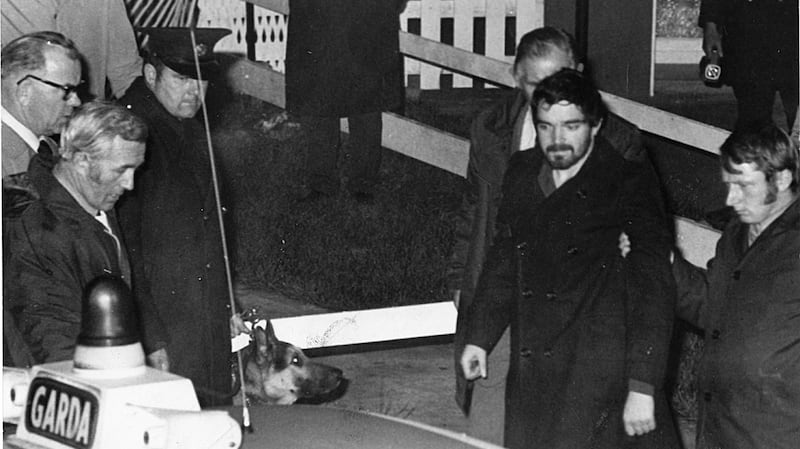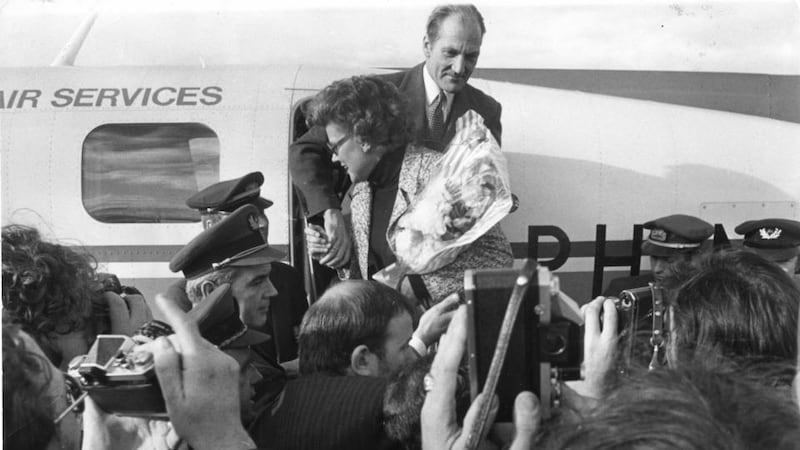The kidnappers’ homework was terrible. They mistook their prisoner for a German. After bundling him into the car they asked him for the name of the German ambassador.
Tiede Herrema gives a wintry laugh. "Yes, they thought I was German. And you see, for a Dutchman, that's terrible when they say you are a German."
Herrema was kidnapped by the IRA on October 3rd, 1975, and held for 36 days by Eddie Gallagher and Marion Coyle. For the final 18 days the authorities knew of their location, and the Army and Garda laid siege to the house where Herrema was being held, in Monasterevin, Co Kildare. He was freed, unhurt, on November 7th, following a negotiation.


The error about his nationality may seem the most trivial of Gallagher and Coyle’s mistakes. The kidnappers’ two big gambles – that a desperate Irish government would cave in, that a hysterical wife’s tears would pile on international pressure – were misjudgments, to put it charitably.
Anyone with a cursory knowledge of Liam Cosgrave's law-and-order government or of Elisabeth Herrema – who, far from crying, spent her time persuading the Dutch that Ireland was perfectly capable of sorting out the problem – could have told them that.
But the biggest gamble – that Herrema himself would be a cowering, silent victim – would be the worst. The reason may lie somewhere in history, ironically, in the fact that he was definitely not German.
Something unusual
The pair must have begun to suspect that there was something unusual about their captive shortly into the 36-day odyssey. For the first 14 days of the ordeal he had no idea where he was, confined to a tiny room in a house, in stinking conditions, feet and hands tied, cotton wool pushed into his ears.
Today Herrema is baffled, even irritated, that interviewers consistently overlook this part. “You all start by asking me about the period in Monasterevin . . . But the other part before, nobody talks about it, and that part was even worse for me. I didn’t know where we were. I didn’t even know how many were in the car that took me there.”
The kidnappers were a fighting, shouting, clueless judder of nerves, waving guns around.
“I had no sense of what they were fighting about. What did they want? They were nervous. As I was. As long as you don’t know where you are, and what they are going to do, you are frightened. Of course you are.”
“We had no idea either. Was he still alive?” Elisabeth interjects.
Herrema, it turned out, was being held in Mountmellick, where the man who diverted himself by doing mathematical puzzles in his head, and regarded any problem, even a kidnapping, as an interesting challenge, was powerless. But he kept his head and possibly his life by promising Gallagher that he wouldn’t try to escape.
Once at St Evin’s Park in Monasterevin, by contrast, surrounded by armoured cars, searchlights, snipers and the hotshots of world media, he knew exactly where he was and what he had to do. He set out to create calm, to humanise himself in his kidnappers’ eyes. His eldest son was about the same age as Gallagher. Coyle, he noted, listened to the conversations but never spoke. “For me that was an indication: be careful with her. As long as I can get them talking I learn something. But she didn’t talk at all. I could never reach her.”
St Evin’s Park was a release after Mountmellick, he says. Even so, once Garda activity reduced all three to total confinement in a box room it became a psychological battlefield. Two jittery captors on a losing spiral with nowhere to run; three guns; no food, no water, no toilet facilities; a concrete floor for a bed; snipers in the garden; no end in sight.
It went on for 18 days.
The coping mechanisms that seemed second nature to him, a man for whom mental challenges were almost a sport, must have seemed odd to his kidnappers. “When the night is over and you have nothing to eat, you have nothing to do. That is very important to understand, because all you have then is the waiting. You cannot tolerate that all day. So you try to make the day.”
Meticulous detail
So in his head, every morning, Herrema got out of bed, washed, dressed, had breakfast, played chess, solved mathematical puzzles. He went through all the motions of a normal day until bedtime came around again. All in meticulous detail, entirely in his head.
In desperation for liquids Gallagher tried filtering his urine through a blanket and drinking it. Herrema advised him to suck his fingers instead, “so he would feel as though he had drunk something”.
In interviews ever since, Herrema has attributed these coping mechanisms to his psychology studies. It always sounded a little unlikely, I suggest. “Well, I had other experiences,” he says. “It doesn’t help to give more details.” It might, I suggest. Then, reluctantly, he adds: “I have been in a concentration camp.”
He was a Dutch resistance fighter in the second World War, aged in his early 20s when the Nazi arrested him. After a brutal interrogation in Prague he was transported to Ratibor – now the Polish town of Racibórz – in German Upper Silesia.
The concentration camp on the edge of the Polish village of Sobibór, he says, was always in the news, “because all the people in there were Jews”, whereas Ratibor was classed in a system of labour camps for prisoners of war.
Ratibor had 142 prisoners of war as of January 1943, more than a fifth of whom were under 14.
“We were freed by the Russians,” he says. “There was a row of people. Half of them were shot. I don’t know why they didn’t shoot me. Then I walked, together with a Frenchman, from Ratibor to Pilsen” – 500km away – “and there we were helped by the Americans . . . It took days.
“We stayed out of site, walking during the night. We needed the help of all those people, but you couldn’t trust anyone because you didn’t know: is it a German, is it a Frenchman, is it a Russian?
“So yes,” he says softly, “I was in the concentration camp, and then you learn how to survive. All the tricks to survive.”
He met Elisabeth, while skating, soon after the war ended, on January 19th, 1946. She immediately decided, “He’s the one,” and they have been challenging one other since, each as stubborn as the other, bound by deep love, humour, mutual respect, discipline and order.
“Yes, discipline and order,” she says. “That’s our character. I envy the Irish, because they can leave things and say, ‘Okay, this is more important now.’ We are so disciplined that sometimes it destroys spontaneous reactions. That’s the other side of discipline.”
Insightful interjections
In fact her spontaneous, insightful interjections reveal more than a dozen psychology texts could about a family that has survived unusual trauma, and they always come laced with humour.
She tells of racing to the Dutch embassy in Dublin to see Herrema after his release, and running up to the bedroom, worried whether he would be the same man.
“There he was, lying in the bed, and he said, ‘Hello’. And I said, ‘Hello’, too. And that was it. And I went down and told the family doctor, ‘He’s all right.’ ”
When he talks about coping during the siege she reminds him that he cried only once, when he allowed himself to think of their youngest son, Harm.
“He decided, ‘If I cry I am weak, I am lost, so I won’t think of him.’ ”
If he decides not to do something, she says, that’s it: he won’t do it. “So he didn’t think of the young fellow again. But that is him. I know he can do that.”
Another spouse might sigh admiringly at such steel; Elisabeth Herrema is too honest for that. “It’s not nice always, because I can’t reach him.”
He nods: “That’s a weakness.”
But she’s only getting into her stride.
“Other proof about what he thinks might make him weak: he never asked me about my feelings when that was going on. Never asked. I told him, of course, but he never asked, because he knows that’s worse for him. He has the feeling that he did that to me, though of course he never wanted to. He never asked, but I know he is like that. It’s not easy, but it’s not a talent. It’s a failure.”
Tiede, pretending bafflement: “What do I have to ask?”
There’s a burst of laughter all around. “All you can do is laugh,” she says. “We are not heroes, and we are not angels. We are just human beings.”
Lifelong game
The thread of rueful humour in these exchanges signifies a lifelong game between them, one that keeps them alert and interesting to one another. But it always holds a nugget of truth.
It’s there in the discussions about their four boys in the aftermath of the kidnapping. Elisabeth tells a story of taking Harm, who was then 12, back by private aircraft to the Netherlands, to be met at the airport by regiments of police and army, and by general uproar.
Fearful tears for his father fought for dominance with the extraordinary, movie-like scene around him: “I can’t help it, but I like this too!” he exclaimed, bursting into tears again.
He got diabetes a few years later, she says. “There are books about it, that people who are very bright and become diabetic when very young have experienced something very traumatic.”
It’s the only time either of them attributes blame. Both believe that their sons were not otherwise affected by the kidnapping. “As long as we, as their parents, were not angry or complaining, just saying nothing about it, they just moved on.”
And what about Tiede and Elisabeth?
They objected to the 15- and 20-year sentences imposed on Coyle and Gallagher. They believe that very long prison sentences are counterproductive.
Herrema understands Gallagher’s rationale for the crime. “Eddie had certain ideas, and he wanted to realise those. He’s okay, he’s nice. She” – Coyle – “is as well, a bit hard, but . . . She is.”
For all their insistence on moving on, they clearly believed that it was important to meet Gallagher and Coyle after their release from prison.
Visit
“We visited Eddie in his house in the North and had a discussion with him. We know about him, know exactly what he is doing.”
They know that the son born to Gallagher and Rose Dugdale is "doing good. He's a bricklayer and had part of his education in Germany."
They also visited Coyle, where the reception was a great deal more guarded. “She is a social worker, happily married with a nice daughter,” says Elisabeth. “She was not afraid of me. I would say she did not know how to approach me. I just sat there and thought, So that’s Marion. She didn’t talk to me.
“Her daughter was very protective of her, behaving as her guard. And I appreciate that: it was her mother. You could see she did not want to be reminded of the past. She had moved on.”
Did that meeting serve any useful purpose?
“It did for me,” says Herrema. “I wanted to see her. And I have seen her now.”
For Elisabeth, however, there is one question that she never got to ask. “I wanted an honest answer. Would she do it again? Did she ever realise what she was doing to a living man, who had nothing to do with it, just take him as a victim and use him for her own goal? I would ask: did you realise what you were doing?
"No, I don't think she did. No, not because I have seen her but because I cannot understand why you would do that, using a human being in that way. So I would ask: Would she do it again? "
She believes that Eddie Gallagher would say no to that question. Herrema disagrees. “He had an idea, and he lived for that and was convinced of his rights.”
She sighs. “Eddie is older. Just older. The age of Jelle [their eldest son]. He’s got the bus pass now.”
Enduring affection
The Herremas remain fascinating not only for their capacity to forgive and seek out the nuances but also for their enduring affection for Ireland – of which they are proud honorary citizens, and to which they return several times a year, renewing acquaintances over rounds of golf in Milltown and a busy social round.
They met Martin McGuinness at one stage. “He was very polite,” Elisabeth says. “He’s a nice man,” Herrema says.
Their ordeal, to that extent, might be seen as having a positive outcome. Elisabeth, with her gift for friendship, likes to say that, as a result of their ordeal, they found two more “sons” in Dublin, who behave as such to this day.
One is Joe Brennan, a young first secretary in the Irish Embassy in the Netherlands back in the 1970s, who by a series of coincidences happened to know Elisabeth’s aunt before the kidnap.
The other is Conor Brady (who later became editor of The Irish Times), the only Irish journalist to fly to the Netherlands for an interview with Herrema after his release.
Back in the Netherlands, with that extraordinary discipline, Herrema pursues his passion for fitness, if a little more slowly, as well as his love for repairing and rebuilding clocks, and a list of hobbies ranging from chess and genealogy to painting watercolours.
Joe Brennan produces some of the delicately painted Christmas cards that friends get each year, and a hilarious exchange ensues between the artist and his wife.
“You don’t think he sat on the side of the road to paint those scenes, do you? He stole them,” she says scornfully.
Herrema concedes, “I’m not original enough to make something up myself. They’re all copies.”
“That’s true. I am his best critic. He is not an artist,” she says triumphantly.
They make couples 50 years younger than them look ancient.

















